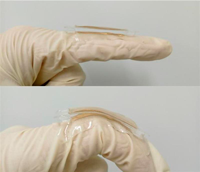 Your body may be the new way to portably charge wearable devices.
Your body may be the new way to portably charge wearable devices.
In a collaborative project, the University at Buffalo (UB) and Institute of Semiconductors at Chinese Academy of Science (CAS) are working together to devise a metallic tab, known as the triboelectric nanogenerator.
The most common form of triboelectric charging is static electricity and the research team has proposed numerous nanogenerators that they believe will utilise this effect.
The idea is that the tab (1.5 centimeters long, by 1 centimeter wide) will attach to the body and generate electricity from small movements such as, bending a finger, which will be delivered to a user’s wearable device.
"No one likes being tethered to a power outlet or lugging around a portable charger. The human body is an abundant source of energy.” says lead author Qiaoqiang Gan. “We thought, why not harness it to produce our own power?”
The challenge is that most nanogenerators that work with triboelectrics are difficult to manufacture or expensive. However, the team claims that the tab they’re developing address both these issues.
The device is said to comprise two thin layers of gold, with polydimethylsiloxane (PDMS) sandwich between. One of the layers of gold is stretched, which according to the team is vital to the operation. This is because it will cause it to crumple upon release and when force is reapplied, for example from a small body movement, the motion creates friction between the gold layers and PDMS.
"This causes electrons to flow back and forth between the gold layers. The more friction, the greater the amount of power is produced," explains another lead author, professor Yun Xu, at CAS.
The researchers say the tab will be capable of delivering a maximum voltage of 124V, a maximum current of 10 microamps and a maximum power density of 0.22 millwatts per square centimeter.
This is currently not quick enough to charge a smartphone, but the researchers say that in their experiments, it did light 48 red LED lights.
Nan Zhang, a PhD student at UB has been tasked with improving this performance. Zhang’s team plan on using larger pieces of gold, which they hope when stretched and folded together will generate more electricity.
The researchers are also working towards a portable battery to store energy produced by the tab, in a hope to one day power wearables and self-powered electronic devices.
Pic: Prototype of the triboelectric nanogenerator
Author
Bethan Grylls
Source: www.newelectronics.co.uk
